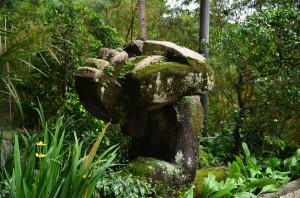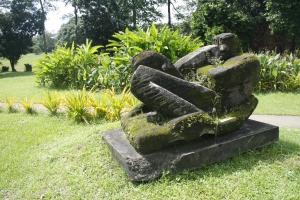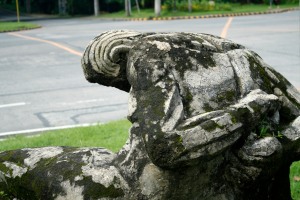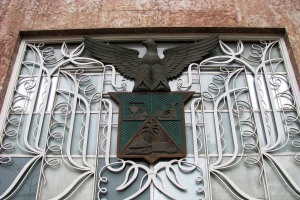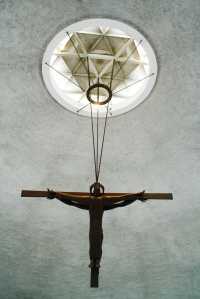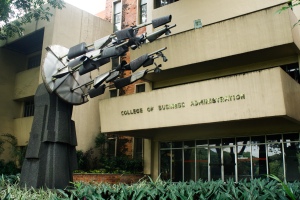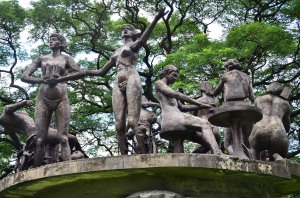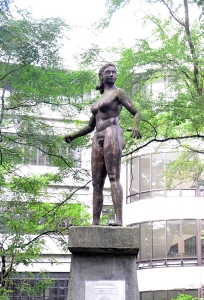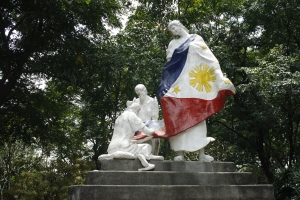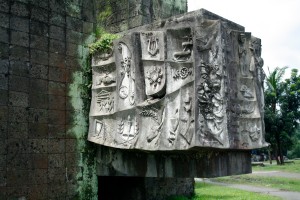Another characteristic work of Marcelo can be found beside the steps of the Main Library. Also made of concrete and adobe, The Challenge is a figure of a man kneeling on his right knee with his face and arched body turned towards the sky. Being entirely covered with moss the sculpture appears to be a natural part of the foliage surrounding it.
Monthly Archives: January 2015
Contemplation (Ildefonso Marcelo)
Contemplation is another figure of a crouching man – lying on his lower back, with knees raised and arms folded in an apparent meditation. Providing a strategic prelude to the acknowledged iconic centerpiece of the University, the Oblation, these sculptures are representations of ideals in pursuit of education: that of imprisonment to ignorance in the case of Captivity, and the importance of thought in the creation of knowledge in the case of Contemplation.
Captivity (Ildefonso Marcelo)
Born in 1941, Ildefonso Marcelo is known for using blocks of stone in creating figures that connote strength and permanence. Owing to this medium, his works are usually massive and closed, making them as if they were part of the environment. Captivity is a figure of a man with hands bound behind his back, his body twisted and head bowed down. Made of concrete and adobe, this figure is found along the University Avenue.
University Seal (Napoleon Abueva)
The University Seal is the welcoming icon at the entrance of the U.P. Main Library. It rests in the middle of a white curvilinear grillwork that is reminiscent of organic shapes and somehow echoes the widespread wings of the copper-colored eagle. The symbolic bird is perched atop a green shield that features emblems representing University ideals and Philippine icons.
Crucifixion (Napoleon Abueva)
As the focal point of the Parish of the Holy Sacrifice, which is in itself an important artistic hub within the campus, the Crucifixion is a double-sided figure of Christ. Facing one side is the crucified image and the resurrected Christ on the other. The elongated figures silently accentuate the solemnity of important moments in the Christian life: that moment of death and sacrifice, and that moment of God’s promise fulfilled. Made of a material Abueva is comfortable with, the hardwood cross is suspended above the altar supported by steel rods.
The Spirit of Business (Napoleon Abueva)
The Spirit of Business, as its title implies can be found in front of the College of Business Administration. Made of metal and done in 1979, the forward thrust of the spear-like elements is symbolic of how it propels us towards progress and development. At some point in the sculpture’s history, there was supposedly a mechanism that made parts of it rotate to further emphasize the drive towards growth and dynamism.
Siyam na Diwata ng Sining (Napoleon Abueva)
The Hardin ng mga Diwata takes its name from and hosts the Abueva sculptural piece, Siyam na Diwata ng Sining. This reinforced concrete work represents the nine muses of art: architecture, dance, film, literature, music, painting, photography, sculpture, and theater. The nude muses, spread around atop a ring-like pedestal are rendered in various stances. Despite strong formal traces of neo-classical influences, their relaxed poses and generous gestures temper the usual severity that the tradition is known for.
Magdangal (Napoleon Abueva)
In celebration of U.P.’s centennial year in 2008, Abueva’s bronze sculpture entitled Magdangal was inaugurated. Situated in front of the College of Arts and Letters building, this work stands on top of a high concrete pedestal as the centerpiece of a mini-park surrounded by trees and concave benches. At the foot of the pedestal, are the words of poet and National Artist for Literature Virgilio Almario which inspired the making of the sculpture.
Three Women Sewing the First Filipino Flag (Napoleon Abueva)
Behind the Amphitheater is Abueva and Sons’, Three Women Sewing the First Filipino Flag which is made of concrete and polychrome, the practice of applying color to sculptures. This work commemorates the sewing of the Philippine flag by Marcela and Lorenza Agoncillo, and Josefina Herbosa while in exile with the Revolutionary Government in Hong Kong from 1897-1898.
Tribute to Higher Education (Napoleon Abueva)
Awarded the National Artist for Visual Arts (Sculpture) in 1976, Napoleon Abueva, is among the foremost Modernist artists in the country. He often experimented with various materials but admitted that he was happiest working with wood. Having served as Dean of the U.P. College of Fine Arts his artworks form a large part of the sculpture collection of the University. His Tribute to Higher Education, which was completed in 1966, are two large concrete sculptures flanking the University Avenue and serve as portals to the Diliman campus. On its surface are symbols representing the various disciplines being offered by the University and images derived from Philippine folklore all in bas relief. Bas relief or low relief is a sculptural technique where the image only projects slightly from the base.

